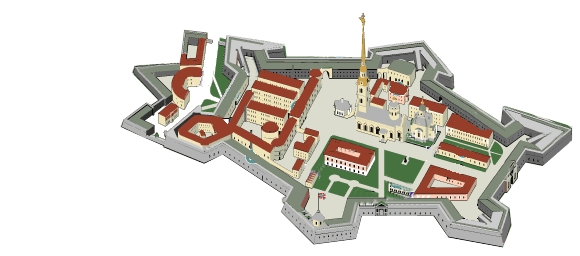Peter and Paul Fortress
SIGHTS ST. PETERSBURG
MUSEUMS OF ST. PETERSBURG
Peter and Paul Fortress

The Peter and Paul Fortress is architectural and historical center of Saint-Petersburg. The fortress was designed to protect the Neva lands that were
won from the Swedes during the Northern War (1700 - 21). Its powerful stone walls rising almost out of the water, and the cathedral spire soaring into the
skies, make up a unique view opening from afar as a part of the wide Neva panorama.
 A Neva island called Zayachy (Hare) or Vesioly (Cheerful) was chosen as a
construction site; its A Neva island called Zayachy (Hare) or Vesioly (Cheerful) was chosen as a
construction site; its
location was unique from the
military point of view. The
wide, deep Neva
served to protect
the fortress, while
the latter, in its turn,
was covering the
entrance to the
Neva from the Gulf
of Finland. The whole
island built up because
of its small size.
On 16 May (27 May, New Style),
1703, the foundation of the fortress was
laid, that was to be named Saint-Petersburg.
This day is considered to be the day when the
city got its start. The city was soon named after
the fortress, Saint-Petersburg. Meanwhile the
fortress acquired the name of Peter and Paul (after the name of the cathedral built there).
Construction of the earthen and wooden fortifications was completed by the
autumn of 1703. The outlines of the fortress depended on the shape of the island
proper; it was designed in the shape of an elongated hexagon with six projecting
bastions. In 1706 they started to rebuild the wooden fortress in stone; the
reconstruction lasted till 1740. This work was entrusted to D.Trezzini, the
forts fortifier and architect of the new capital.
The Peter and Paul Fortress was put up for fortification purposes; however, it
had never been used as such. Beginning from 1718 it was turned into a prison for
political convicts. Since 1924 Peter and Paul Fortress has been a museum.
The Peter and Paul Cathedral is a unique sample of Russian 18th-century
architecture that has reached us. Its grand multi-tier belfry with a gilt spire
is an architectural dominant of the city, an integral part of its silhouette.
The Peter and Paul Cathedral had for almost two centuries served as a
burial-place for Russian emperors. This was done at the order of Peter I, who is
himself buried at the southern wall of the cathedral.
For a long time the cathedral had performed the functions of the museum of
Russian military glory, where enemy banners, keys of the cities and fortresses
captured by Russian troops were kept. In the early 20th century all the trophies
were transferred to museums. The cathedral now holds replicas of captured
Swedish and Turkish banners. The building, topped with a dome and a bulbous
cupola is perceived as an integral part of the cathedral. In front of the
entrance a fence was put up, designed on the model of the Summer Gardens
railing.
A LANDMARK ON THE GOOGLE PANORAMA:
ADDITIONAL INFORMATION:
PAGES OF THE PICTURE ALBUM
|